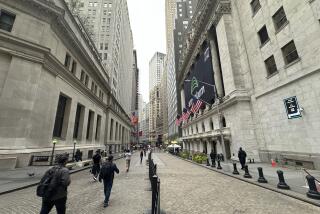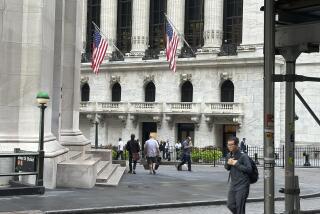Mideast-Ignited Stock Crash Seen as Unlikely : Investing: Things were different in 1987. Now fewer market players are overextended and downside “circuit breakers” are in place.
- Share via
It reads like a paragraph out of last week’s newspaper: “Stock prices plunged as fear of higher interest rates, higher inflation and increased Middle East tensions . . . gripped individual and institutional investors.”
But, in fact, those words were written Oct. 19, 1987, after the record 508-point plunge in the Dow Jones industrial average.
Although the market began to recover almost immediately after that historic fall, the drop caused financial ruin for some investors and brokerages and scared many away from the market for good.
Today’s troubles and those that toppled the market three years ago are disconcertingly similar, experts note. Not only is the economy in much the same precarious position as then, but the United States is again flirting with war in the Middle East.
However, few believe that the stock market is headed for another historic plunge.
“You get real market crashes when investors have high expectations and high margin exposure,” said Michael Metz, market strategist at Oppenheimer & Co. in New York. Right now, investors are pessimistic. Instead of borrowing to buy stocks, they are hoarding cash, Metz said.
Added Eugene E. Peroni Jr., director of technical research at Janney Montgomery Scott in Philadelphia: “The sentiment is quite a bit more bearish than it was in 1987. I would doubt that investors could be broadsided, unless something really catastrophic were to occur externally.”
Stocks, which were selling for more than 20 times earnings in 1987, are now selling for less than 16 times earnings--still a high price by historic standards but certainly not as out of sync with normal levels as in the past, added Rich Bernstein, manager of quantitative analysis at Merrill Lynch Capital Markets in New York.
Additionally, stock exchanges and large brokerages have instituted safeguards meant to discourage severe one-day declines.
The New York Stock Exchange, for example, has a number of so-called circuit breakers that go into effect when stocks fall fast and furiously. One such circuit breaker temporarily cuts off computerized sell programs, another halts trading in specific stocks when there are severe market imbalances and others can stop trading on the entire exchange for up to two hours at a time.
In theory, those trading halts would give investors time to reconsider any panic selling.
Meanwhile, many of the nation’s biggest brokerages have backed out of computerized program trading, which was blamed, in part, for the October 1987 free fall. Other investment houses said they would adhere to strict guidelines that would keep them from selling stocks when market conditions suddenly went sour.
Still, some experts downplay the effectiveness of these measures in preventing a crash.
“You cannot synthetically stop a market from declining,” said Kenneth L. Fisher, president of Fisher Investments in Woodland, Calif. “In fact, you could argue that they would make things worse.” Investors might get panicky if they were unable to trade because of a market halt, he added.
Others doubt that Wall Street firms would stick by their internal guidelines if it threatened to cost the brokerage money.
Instead, the experts said, the biggest deterrent to a severe plunge is the absence of a lot of inexperienced investors in the market. In the past, there were many of those investors--and they were convinced that the market would continue to rise just because it had for years.
However, all this does not mean that stock values are about to stabilize or head higher. Although there may not be a swift drop, many expect stock values to continue to slowly erode by as much as 20% from current levels. If the economy falters, the market could slip even more.
More to Read
Inside the business of entertainment
The Wide Shot brings you news, analysis and insights on everything from streaming wars to production — and what it all means for the future.
You may occasionally receive promotional content from the Los Angeles Times.










